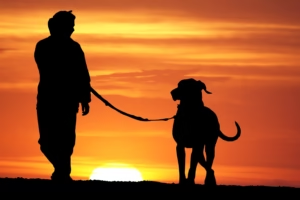Understanding Your Dog’s Behavior and How to Create Calm, Confident Interactions
You’re walking down the trail in Eagle River or heading into your favorite Anchorage park when, boom, your dog spots another dog and erupts. The barking, lunging, or whining starts before you can even say “heel.” It’s embarrassing, stressful, and confusing. After all, your dog is friendly at home, so why do they bark so much at other dogs?
At Alaska Dog Works, we hear this question from clients every week. The good news? Barking at other dogs is one of the most common behaviors we address, and with the right training, it’s absolutely fixable.
The Real Reason Dogs Bark at Other Dogs
Before labeling your dog as “aggressive,” it’s important to understand what’s actually happening. Barking is communication, not defiance. Your dog is using their voice to express emotion or intent, and that emotion could stem from several causes.
1. Frustration: “I just want to say hi!”
Some dogs bark out of excitement or frustration when they can’t reach another dog. They might love playing at dog daycare or the dog park, but on leash, that excitement turns into an explosion of sound. The leash creates a sense of restraint that intensifies their desire to interact, what trainers call barrier frustration.
2. Fear or Uncertainty
For other dogs, barking is rooted in fear. Maybe your dog was startled by a larger dog in the past, or maybe they simply never had enough positive social experiences as a puppy. When faced with something unfamiliar, the bark acts as a defensive strategy: “I’m not sure about you, so I’ll bark to keep you away.”
3. Territorial or Protective Instincts
If your dog tends to bark out the window, fence, or from the back seat of your car, they may be protecting their space or you. This behavior often stems from confidence imbalance or over-responsibility within the pack, your dog has decided that guarding is their job.
4. Lack of Focus and Impulse Control
Sometimes barking has less to do with fear or excitement and more to do with poor impulse control. Dogs that haven’t been taught how to redirect their attention toward their handler when distractions appear simply react by default, barking, pulling, and lunging.
Why Leash Reactivity Is So Common
Leash reactivity, the barking, lunging, or whining you see when dogs encounter others on leash, is a behavioral pattern created by a combination of instinct, emotion, and learned habits. Alaska’s wide-open spaces can make this more confusing. Dogs get used to running free on trails or large yards, so the second they’re on leash in a city environment like Anchorage or Wasilla, they feel trapped.
When dogs learn that barking “makes the other dog go away,” the habit is reinforced. The behavior works, so your dog keeps doing it.
The Science of Canine Communication
Dogs read each other through subtle signals: body posture, ear position, tail carriage, and energy. But humans often miss these early cues. Before the bark, your dog’s body may stiffen, pupils dilate, or hackles raise. Recognizing these precursors gives you time to redirect before the outburst happens.
At Alaska Dog Works, we teach our clients to become fluent in “dog body language.” When you can identify signs of stress or excitement, you can interrupt the escalation early and calmly guide your dog through the situation.
The Role of Early Socialization
Puppies have a critical socialization window between roughly 3 and 14 weeks of age. During this time, positive experiences with other dogs, people, and environments shape how they respond to the world as adults. A dog that missed out on proper exposure might bark at other dogs simply because they’re unsure how to behave.
Even adult dogs can benefit from controlled social exposure. In our Peak Performance Training and Lead Dog Service Dog Program, we emphasize slow, structured introductions that build confidence instead of chaos.
Common Mistakes Owners Make
If your dog barks at other dogs, your instinct might be to pull harder on the leash, scold them, or walk away quickly. Unfortunately, these reactions often make the problem worse.
Here’s why:
Tight leashes create tension. When you pull back, your dog feels trapped and may escalate their response.
Yelling adds energy. Dogs mirror the energy around them; if you get anxious or loud, they will too.
Avoidance prevents learning. Avoiding all dog encounters doesn’t teach your dog how to stay calm, it just limits their opportunities to practice appropriate behavior.
Instead, your goal should be to teach your dog that calm behavior earns rewards and that you will handle situations confidently.
How Alaska Dog Works Approaches Barking and Reactivity
Every dog is different, which means every training plan must be tailored. At Alaska Dog Works, our trainers follow a proven process rooted in relationship-based training, real-world exposure, and measurable results.
1. Assessment and Strategy
We start with a one-on-one strategy session to evaluate your dog’s triggers, temperament, and current training foundation. This session helps us determine whether the behavior stems from fear, excitement, frustration, or a combination.
2. Foundation Skills
Next, we focus on impulse control, attention, and engagement, skills like look, heel, and leave it. By strengthening your dog’s focus on you, we make it easier to redirect them before they react.
3. Desensitization and Counter-Conditioning
We gradually expose your dog to controlled encounters with other dogs while rewarding calm behavior. Over time, this rewires their emotional response from “I must bark!” to “I can stay calm.”
4. Real-World Proofing
Because Alaska Dog Works trains dogs to perform in real environments, from downtown Anchorage sidewalks to trailheads in Palmer, we help you practice calm behavior in varied settings. The goal is not just obedience in a classroom but confidence everywhere.
Service Dogs, Therapy Dogs, and Barking
In programs like our Lead Dog Service Dog Training, barking is a critical issue we must address early. A service dog must remain composed around other dogs in public, airports, hospitals, schools, or restaurants. For these dogs, we focus on neutrality: teaching them to observe without engaging.
Interestingly, many pet owners can benefit from the same techniques we use in service-dog training:
Reinforcing focus through structured routines
Building calm confidence through task-based exercises
Strengthening the handler-dog partnership with clear leadership and trust
Training Tips You Can Try at Home
While professional training offers faster results, there are several things you can begin doing today to reduce your dog’s barking at other dogs.
1. Stay Calm and Neutral
Your dog looks to you for cues. If you tighten the leash or gasp, your dog reads your tension as a signal that the other dog is a threat. Keep breathing, keep walking, and maintain a loose lead.
2. Increase Distance
Distance is your friend. Start at a range where your dog notices the other dog but doesn’t react. Reward calm focus. Over time, gradually close that distance as your dog learns to cope.
3. Teach an Alternative Behavior
Train a cue like “watch me” or “heel” that redirects your dog’s focus to you when another dog appears. Reward with high-value treats, chicken, cheese, or whatever motivates your dog most.
4. Avoid Overexposure
Don’t flood your dog with too much at once. Too many close-range encounters too soon can backfire. Quality over quantity always wins.
5. Practice Engagement Indoors
Build engagement in a distraction-free environment first. Work on eye contact, recall, and calm sits in the house before taking it outside.
When to Seek Professional Help
If your dog’s barking includes growling, lunging, or snapping, or if it’s escalating instead of improving, it’s time to consult a professional trainer. Barking at other dogs can sometimes progress into full-blown reactivity or aggression if not addressed correctly.
Our certified trainers at Alaska Dog Works specialize in identifying root causes and developing customized plans for dogs of all breeds and temperaments. Whether your dog needs behavior modification, service-dog-level obedience, or therapy-dog calmness, we have a program that fits.
The Alaska Dog Works Advantage
What sets us apart is our holistic philosophy: we train both ends of the leash.
We don’t just teach dogs commands; we teach owners how to lead confidently and communicate effectively. Our clients see lasting change because the partnership, not just the training, transforms.
Over 20 years of experience in advanced obedience and service-dog training
Customized training plans for reactivity, aggression, and behavioral rehabilitation
In-home, on-trail, and in-community sessions to ensure real-world success
Ongoing support through our Peak Performance Membership
When your dog learns to trust you and you learn to lead with clarity, barking at other dogs becomes a thing of the past.
Building a Better Relationship with Your Dog
Remember: barking is a symptom, not a personality flaw. Your dog isn’t “bad.” They’re communicating the only way they know how. With structure, consistency, and expert guidance, you can teach them to replace that barking with calm focus and confidence.
Every successful outcome at Alaska Dog Works begins with a single step: understanding the why behind your dog’s behavior. Once you understand that, you can build the relationship you’ve always wanted, one based on trust, respect, and teamwork.
Call to Action
If your dog barks at other dogs and you’re ready to fix it for good, schedule a strategy call today with the trainers at Alaska Dog Works. We’ll help you uncover the root cause, design a clear training plan, and teach you the same focus-building techniques we use with our Lead Dog Service Dog clients.
👉 Call 206-752-DOGS or visit AlaskaDogWorks.com to schedule your strategy call.
We offer a FREE Strategy Call.
Click on the graphic to learn more
Read More


Beyond ‘Sit’ and ‘Stay’: How Premium Training Prepares Your Dog for Real-World Alaskan Challenges








